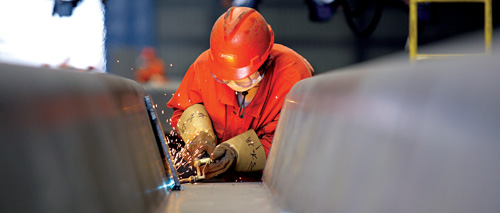One of the largest, most complex construction projects ever undertaken in California is happening right under our noses and yet has been largely unnoticed by Bay Area residents.

Simulated view of the Self-Anchored Suspension portion of the new Bay Bridge East Span, looking east.
By Marjorie Blackwell
Published: March, 2008
Though new temporary structures taking shape east of Yerba Buena Island are now beginning to draw attention, the magnitude of building the new East Span of the San Francisco-Oakland Bay Bridge can be fully grasped only from the air or the Bay, or perhaps from imagination.
The towering cranes that hovered for 18 months over the Skyway section of the new span are now gone, the only visible sign that construction of this portion of the span is actually finished. Substantially completed as of last December, the 1.3-mile Skyway consists of parallel road decks and a 15-foot wide bicycle/pedestrian path, rising gracefully across Bay mudflats from the construction site for the Oakland Touchdown that will connect to the shoreline. To the west, the Skyway now ends abruptly in mid-air above the Bay, waiting to be linked to the Self-Anchored Suspension span that will bridge the deep-water channel to Yerba Buena Island and connect to the island tunnel.
The sleek but unpretentious Skyway marks a record in California construction history. Its road decks consist of 452 of the largest concrete segments ever precast, each three stories high and weighing up to 780 tons. Its 28 enormous concrete foundations sit atop steel-pipe pilings driven up to 300 feet into stable Bay soils for unprecedented earthquake safety.
By far the most dramatic and difficult Skyway construction task was lifting carefully into place two enormous steel bridge sections, each weighing over 1,700 tons, to form a transition span between the Skyway and the suspension span. To raise these 200- by 85-foot, steel box girder bridges 150 feet above the waterline required special jacks and two custom-built, 175-foot tall towers. These lift operations – the heaviest in California history – together took more than 30 hours to complete.
Meanwhile, construction of the even more complex suspension span, the largest public works contract in California history, began before the Skyway was completed. This 1,263-foot span will be the longest single-tower, self-anchored suspension bridge in the world. The single tower is comprised of four separate segments, and building it is truly a global undertaking. Its components are being fabricated around the world, from as near as Vallejo and Napa to South Korea, China, Norway and England. A specially designed crane barge, for example, is being built in Portland, Oregon, that will carry and lift the heavy steel tower pieces being constructed in Shanghai, China. The suspension cable system is being built in South Korea, while the hydraulics for the cable compaction machine are coming from Oslo, Norway.
Constructing the $1.75 billion suspension span actually requires building several temporary bridges. One will be a detour to maintain traffic flow between the island’s tunnel and the existing East span while a permanent transition structure is built to connect to the tunnel. Others will never carry traffic but will support the tower’s steel deck sections until the steel suspension cable is strung, anchoring the deck to the tower.
The foundations for the suspension span are nearly complete. A steel-and-concrete octagon as big as a basketball court, with a forest of steel posts sticking out of the top, comprises the foundation for the steel tower, supported by piles driven 200 feet into bedrock. When the four separate legs of the 525-foot tall tower arrive by barge from China in 2009, they will be lifted into place and anchored to the steel pins.
Bay Bridge motorists definitely will be aware of the East Span construction in spring 2009 when the temporary bridge detour to and from the Yerba Buena Island tunnel opens, likely requiring a reduced speed limit. But this minor inconvenience still will not fully reveal the immense construction project going on around us. That may have to wait until the new span is completed in 2013.

A worker smoothes the surface of a “U-rib” that will form part of the new bridge deck.

Enormous deep water foundations support the towers that will connect the Skyway section to the Self-Anchored Suspension Span.

